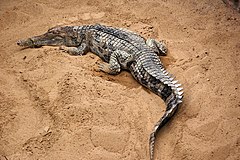Gawialowate
| Gavialidae | |
| Adams, 1854 | |
 Gawial gangesowy (Gavialis gangeticus) | |
 krokodyl gawialowy (Tomistoma schlegelii) | |
| Systematyka | |
| Domena | |
|---|---|
| Królestwo | |
| Typ | |
| Podtyp | |
| Gromada | |
| Infragromada | |
| Rząd | |
| Nadrodzina | |
| Rodzina |
gawialowate |
Gawialowate (Gavialidae) – rodzina krokodyli reprezentowana obecnie przez jeden gatunek, gawiala gangesowego (Gavialus gangeticus)[1], choć czasami zalicza się doń krokodyla gawialowego (Tomistoma schlegelii), który wedle Reptile Database ten drugi należy do rodziny krokodylowatych (Crocodylidae)[2]. Te dwa gatunki są do siebie podobne, ale ich areał występowania nie pokrywa się[1]. Do Gavialidae należy także m.in. wymarły Rhamphosuchus, jeden z największych krokodyli w historii[3].
G. gangesowy występuje w Bangladeszu, Bhutanie, Birmie, północnych Indiach, Nepalu i Pakistanie[1], a k. gawialowy – Indonezji, Malezji, północnej Tajlandii oraz Wietnamie[2].
Gawiale mierzą od 5 (dorosły samiec T. schlegelii)[4] do ponad 9 metrów (samiec G. gangeticus)[5]. Charakteryzują się delikatnym, wąskim pyskiem i długimi ostrymi zębami[1].
Polują na ryby i drobne zwierzęta, żywią się też padliną. Ich szczęki są określane jako zbyt delikatne, by łapały zwierzęta, takie jak ssaki, ale krokodyl gawialowy, jak się okazuje, jest generalistą spożywającym też kopytne[6]. Gawial jest czczony jako zwierzę święte.
Systematyka
[edytuj | edytuj kod]- Rodzina: gawialowate
- Rodzaj Gavialis
- gawial gangesowy (Gavialis gangeticus)
- Rodzaj Tomistoma
- krokodyl gawialowy (Tomistoma schlegelii)
- Rodzaj Gavialis
Przypisy
[edytuj | edytuj kod]- ↑ a b c d Gavialis gangeticus (GMELIN, 1789), [w:] The Reptile Database [online] [dostęp 2024-08-06] (ang.).
- ↑ a b Tomistoma schlegelii (MÜLLER, 1838, [w:] The Reptile Database [online] [dostęp 2024-08-06] (ang.).
- ↑ Darren Naish: The world's largest modern crocodilian skull. Tetrapod Zoology. [dostęp 2008-12-02]. (ang.).
- ↑ A.A. Ahmad i inni, Multi-organ Metastasis of Fibrolamellar Hepatocellular Carcinoma in a Malayan Gharial (Tomistoma schlegelii), „Journal of Comparative Pathology”, 2-3, 157, 2017, s. 80-84, DOI: 10.1016/j.jcpa.2017.06.007 [dostęp 2024-08-06] (ang.).
- ↑ S.S. Flower, The Gharial, Garialis gangeticus, „Report on a zoological mission to India in 1913”, 1914, s. 21 [dostęp 2024-08-06] (ang.).
- ↑ W.E. Magnusson, Encyclopedia of Reptiles and Amphibians, H.G. Cogger, R.G. Zweifel (red.), San Diego: Academic Press, 1998, s. 229–230, ISBN 978-0-12-178560-4 [dostęp 2024-08-06] (ang.).
Text is available under the CC BY-SA 4.0 license; additional terms may apply.
Images, videos and audio are available under their respective licenses.


